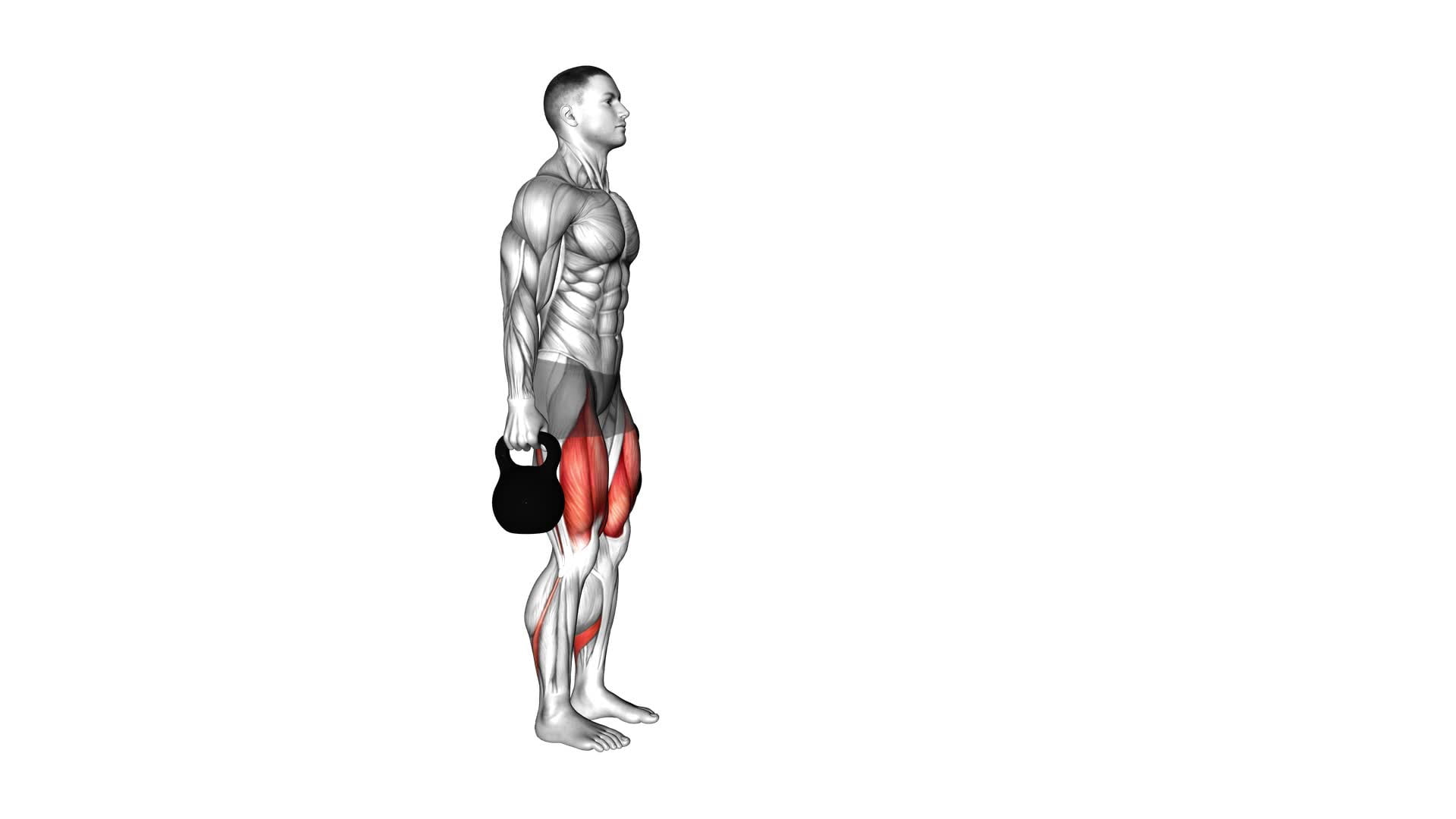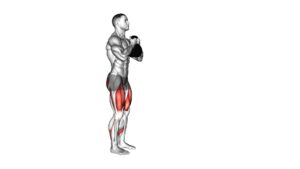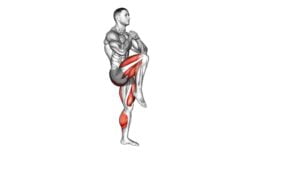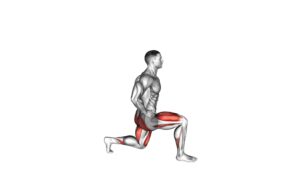Kettlebell Forward Lunge – Video Exercise Guide & Tips

Are you looking to take your lunges to the next level? Then the Kettlebell Forward Lunge is the exercise for you!
Watch This Exercise Video
In this video exercise guide, we'll show you how to perform the forward lunge with a kettlebell, ensuring proper form and technique. You'll also learn how to choose the right kettlebell weight and avoid common mistakes.
Plus, we'll share variations and progressions to keep challenging yourself.
Get ready to maximize your results with this powerful exercise!
Key Takeaways
- Increased lower body strength
- Improved balance and stability
- Targets quadriceps, hamstrings, glutes, and calves
- Engages core and supports spine for proper posture and prevention of lower back injuries
Benefits of the Kettlebell Forward Lunge
You can experience increased lower body strength and improved balance through the benefits of performing the Kettlebell Forward Lunge. This exercise isn't only effective but also versatile, as it can be modified to suit your fitness level and goals. By incorporating kettlebell lunge variations into your routine, you can target different muscles and add variety to your workouts.
The Kettlebell Forward Lunge engages your quadriceps, hamstrings, glutes, and calves, making it a great exercise for strengthening and toning your lower body. As you step forward and lower into the lunge position, your leg muscles are activated, helping to build strength and endurance. The added resistance from the kettlebell increases the intensity of the exercise, further challenging your muscles.
In addition to lower body strength, the Kettlebell Forward Lunge also improves your balance and stability. By forcing your body to maintain a stable position while performing the exercise, you engage your core muscles, as well as the muscles in your feet and ankles. This can help improve your overall balance and coordination, which is essential for everyday activities and sports performance.
Incorporating lunges into a full body workout is a smart move as they work multiple muscle groups simultaneously. They can be combined with other exercises to create a well-rounded routine that targets your upper body, core, and lower body. By incorporating kettlebell lunge variations into your workouts, you can continue to challenge yourself and make progress towards your fitness goals.
Now that you understand the benefits of the Kettlebell Forward Lunge, it's important to focus on proper form and technique to maximize its effectiveness and prevent injury.
Proper Form and Technique
When performing the kettlebell forward lunge, it's important to focus on engaging your core throughout the movement. This will help maintain stability and prevent any strain on your lower back.
Additionally, pay attention to your foot placement and balance to ensure proper form and avoid any unnecessary stress on your joints.
Core Engagement During Lunges
Maintaining proper core engagement is essential for executing lunges with proper form and technique. When your core stability is strong, it helps to stabilize your body during the movement and prevents unnecessary strain on your lower back.
Here are three reasons why core engagement is crucial during lunges:
- Increased muscle activation: By engaging your core, you activate more muscles throughout your body, including your abdominals, obliques, and lower back. This leads to a more effective and efficient lunge exercise, as it engages multiple muscle groups simultaneously.
- Improved balance and posture: A strong core helps you maintain an upright posture and balance during lunges. It prevents excessive forward or backward leaning, ensuring that your body stays aligned and stable throughout the movement.
- Injury prevention: By keeping your core muscles engaged, you provide support and stability to your spine, reducing the risk of lower back injuries. It also helps maintain proper form, preventing strain on your knees and hips.
Foot Placement and Balance
To ensure proper form and technique during kettlebell forward lunges, it's important to focus on foot placement and balance. The position of your feet plays a crucial role in maintaining stability and control throughout the exercise.
When performing the lunge, start by standing tall with your feet hip-width apart. As you step forward into the lunge, make sure to land on the heel of your front foot, with your toes pointing forward. This will help distribute your weight evenly and provide a solid foundation for the movement.
Additionally, pay attention to your balance by keeping your core engaged and your chest lifted. By maintaining proper foot placement and balance, you can maximize the effectiveness of the kettlebell forward lunge while minimizing the risk of injury.
Choosing the Right Kettlebell Weight
To ensure an effective and safe workout, it's important that you select the appropriate kettlebell weight. Choosing the right weight won't only help you progress in your fitness journey but also prevent injuries. Here are three key factors to consider when selecting your kettlebell weight:
- Fitness Level: It's crucial to choose a weight that suits your current fitness level. If you're just starting out or have limited strength, opt for a lighter kettlebell to focus on proper form and technique. As you become more comfortable and stronger, gradually increase the weight to continue challenging yourself.
- Exercise Specificity: Different exercises require different kettlebell weights. For example, a heavier weight may be suitable for swings or deadlifts, while a lighter weight may be more appropriate for exercises that involve overhead movements. Consider the specific exercises you'll be performing and choose a weight that allows you to maintain proper form throughout the movement.
- Listen to Your Body: Ultimately, your body knows best. Pay attention to how your body feels during your workouts. If you find that the weight is too heavy and compromising your form, it's better to scale back and choose a lighter kettlebell. Remember, it's more important to perform the exercises correctly than to lift heavy weights.
Common Mistakes to Avoid
One common mistake to avoid when performing the kettlebell forward lunge isn't properly engaging your core throughout the movement. Your core plays a crucial role in stabilizing your body and maintaining proper form during the exercise. Neglecting to activate your core can lead to poor balance and potential injury. To ensure you're engaging your core correctly, imagine pulling your belly button towards your spine and maintaining a strong, stable center throughout the entire lunge.
Another common mistake is allowing your front knee to extend past your toes. This places excessive stress on the knee joint and can lead to discomfort or injury. Instead, focus on keeping your front knee directly above your ankle, maintaining a 90-degree angle.
Lastly, avoid leaning too far forward or backward during the exercise. This can compromise your balance and form. Keep your torso upright and aligned with your hips and avoid excessive leaning in any direction.
Variations and Progressions
Now let's explore the different lunge variations and progressions to keep challenging and improving your kettlebell forward lunges.
By incorporating variations such as the reverse lunge or lateral lunge, you can target different muscles and intensify the exercise.
As you get stronger and more comfortable, you can also increase the difficulty by adding more weight to your kettlebell or performing the lunges on an unstable surface like a balance board.
Different Lunge Variations
Try incorporating different lunge variations into your workouts to challenge your lower body muscles and progress your fitness level. Here are three variations that will take your lunges to the next level:
- Curtsy Lunges: Step one foot behind and across the opposite leg, keeping your hips square. This variation targets your glutes and outer thighs, adding a new dimension to your lunge routine.
- Reverse Lunges: Instead of stepping forward, take a step back with one foot. This variation puts more emphasis on your hamstrings and glutes, helping to improve your balance and stability.
- Walking Lunges: Instead of staying in one spot, take a step forward with each lunge, alternating legs as you move forward. This not only challenges your leg muscles but also improves your cardiovascular endurance.
Increasing Difficulty Over Time
To progress your lunges and continue challenging your lower body muscles, incorporate variations and progressions over time.
There are several progression options you can try to make your kettlebell forward lunges more challenging. One option is to increase the weight of the kettlebell you're using. This will require your muscles to work harder to stabilize and move the heavier weight.
Another option is to add a plyometric element to your lunges. You can do this by performing jump lunges, where you switch legs in mid-air and land in a lunge position. This will increase the intensity and power required for the exercise.
Additionally, you can try performing the lunges on an unstable surface, such as a balance board or wobble cushion. This will engage your core muscles even more as they work to stabilize your body during the exercise.
Incorporating these advanced modifications will help you continue to challenge and strengthen your lower body muscles.
Tips for Maximizing Your Results
To maximize your results, focus on proper form and technique during the kettlebell forward lunge exercise. Here are three advanced techniques that will help you get the most out of your workout:
- Engage your core: As you perform the forward lunge, actively engage your core muscles by pulling your belly button in towards your spine. This won't only help stabilize your body but also increase the intensity of the exercise, leading to better results.
- Maintain a controlled tempo: Avoid rushing through the movement. Instead, focus on maintaining a slow and controlled tempo throughout the exercise. This will ensure that you're targeting the right muscles and maximizing the effectiveness of each lunge.
- Increase the weight gradually: As you become more comfortable with the kettlebell forward lunge, gradually increase the weight of the kettlebell. This progressive overload will challenge your muscles and stimulate further growth, helping you achieve your fitness goals faster.
By implementing these tips, you can take your kettlebell forward lunge to the next level and maximize your results. Remember to always listen to your body and adjust the intensity according to your fitness level.
Happy lunging!
Frequently Asked Questions
How Many Sets and Reps Should I Do When Performing the Kettlebell Forward Lunge?
When performing the kettlebell forward lunge, you might be wondering how many sets and reps you should do. Sets and reps can vary depending on your fitness level and goals.
For beginners, it's recommended to start with 2-3 sets of 8-10 reps on each leg. As you progress, you can increase the number of sets and reps to challenge yourself.
Remember to listen to your body and make modifications as needed to ensure proper form and prevent injury.
Can I Do the Kettlebell Forward Lunge if I Have Knee Pain or a Knee Injury?
If you have knee pain or a knee injury, you might want to modify the kettlebell forward lunge. There are alternative lunge variations that can be less stressful on your knees. It's important to listen to your body and not push through any pain.
Consider trying exercises like the reverse lunge or the lateral lunge, which can provide similar benefits without putting as much strain on your knees. Always consult with a healthcare professional before starting any new exercise routine.
Is It Better to Perform the Kettlebell Forward Lunge With a Heavier Weight or More Repetitions?
When it comes to the kettlebell forward lunge, the choice between using a heavier weight or doing more repetitions depends on your goals.
If you're looking to build strength and muscle, using a heavier weight will be more effective.
However, if you want to improve endurance and burn calories, focusing on more repetitions is the way to go.
Both approaches have their benefits, so it's important to consider what you want to achieve with this exercise.
Can I Incorporate the Kettlebell Forward Lunge Into a Full Body Workout Routine?
Yes, you can definitely incorporate the kettlebell forward lunge into your full body workout routine. This exercise targets multiple muscle groups, including your legs, glutes, and core, making it a great addition to a comprehensive workout.
Are There Any Specific Breathing Techniques That I Should Follow While Performing the Kettlebell Forward Lunge?
When performing the kettlebell forward lunge, it's important to focus on your breathing technique. Take a deep breath in as you step forward and lower your body into the lunge.
Exhale as you push back up to the starting position. This helps stabilize your core and provide the necessary oxygen to your muscles.
If you have knee pain or injury, make sure to modify the exercise by reducing the range of motion and using lighter weight.
Conclusion
Incorporating kettlebell forward lunges into your workout routine offers numerous benefits, including improved lower body strength and stability. By maintaining proper form and technique, choosing the appropriate kettlebell weight, and avoiding common mistakes, you can maximize your results.
Additionally, incorporating variations and progressions can help keep your workouts challenging and exciting. Remember to challenge yourself, but also listen to your body and adjust as needed.
Start incorporating kettlebell forward lunges into your fitness regimen today and start reaping the benefits.

Author
Years ago, the spark of my life’s passion ignited in my mind the moment I stepped into the local gym for the first time. The inaugural bead of perspiration, the initial endeavor, the very first surge of endorphins, and a sense of pride that washed over me post-workout marked the beginning of my deep-seated interest in strength sports, fitness, and sports nutrition. This very curiosity blossomed rapidly into a profound fascination, propelling me to earn a Master’s degree in Physical Education from the Academy of Physical Education in Krakow, followed by a Sports Manager diploma from the Jagiellonian University. My journey of growth led me to gain more specialized qualifications, such as being a certified personal trainer with a focus on sports dietetics, a lifeguard, and an instructor for wellness and corrective gymnastics. Theoretical knowledge paired seamlessly with practical experience, reinforcing my belief that the transformation of individuals under my guidance was also a reflection of my personal growth. This belief holds true even today. Each day, I strive to push the boundaries and explore new realms. These realms gently elevate me to greater heights. The unique combination of passion for my field and the continuous quest for growth fuels my drive to break new ground.



